What does it mean to be Filipino? It’s a question that gets to the heart of culture and heritage. The Filipino experience is rich and varied, influenced by history, traditions, and personal stories. Many Filipinos struggle to find their place in this complex world.
The diversity of Filipino society is often missed. This misunderstanding makes it hard to understand what it means to be Filipino. To truly grasp this, we must explore the many facets of Filipino identity. These include language, history, customs, and food.
As the nation moves forward, it’s time to reflect on who we are. This reflection is key to understanding the Filipino identity. It’s about embracing our diversity and the stories that make us unique.
Key Takeaways
- Filipino identity is complex and evolving, shaped by culture and heritage.
- Diversity within Filipino society is often overlooked, leading to a misunderstanding of the Filipino identity.
- Foundational signifiers like language, history, customs, and food influence Filipino identity.
- Engaging with diverse experiences is essential to understanding the depth of Filipino identity.
- A collective reflection on the Filipino national identity is necessary for the nation’s progress.
- Filipino identity is shaped by personal experiences and biases.
- Understanding the complexity of Filipino identity is key to grasping what it means to be Filipino.
The Many Facets of Filipino Identity
The Filipino identity is complex, shaped by history, culture, and personal experiences. It’s about feeling part of a community with shared values. The Philippines, with over 7,000 islands, has diverse landscapes, languages, and cultures. These have all shaped the Filipino identity.
Spanish and American colonization have left a mark on Filipino culture and values. The idea of kapwa (fellowship or togetherness) is key in Filipino society. It highlights the importance of community and shared identity. Filipinos show respect by using terms like ‘kuya’ for older males and ‘ate’ for older females.
Finding Filipino identity means having open conversations and celebrating diversity. Important parts of Filipino identity include:
- Birthplace and language proficiency
- Cultural heritage and traditions
- Family and social relationships
- Personal values and beliefs
Grasping these aspects of Filipino identity helps us appreciate its complexity and richness. By embracing diversity and promoting a sense of belonging and personal connection, Filipinos can build a stronger national identity.
The Colonial Legacy in the Philippines
The Philippines has a rich and complex history. Many colonial powers have shaped its culture and heritage. The Spanish and American colonizations have left a lasting impact, influencing how Filipinos see themselves and their place in the world.
Colonial mentality is a big part of this legacy. It makes Filipinos feel less than others from foreign cultures. This leads to wanting to be like others, preferring foreign products, and dreaming of moving abroad for a better life.
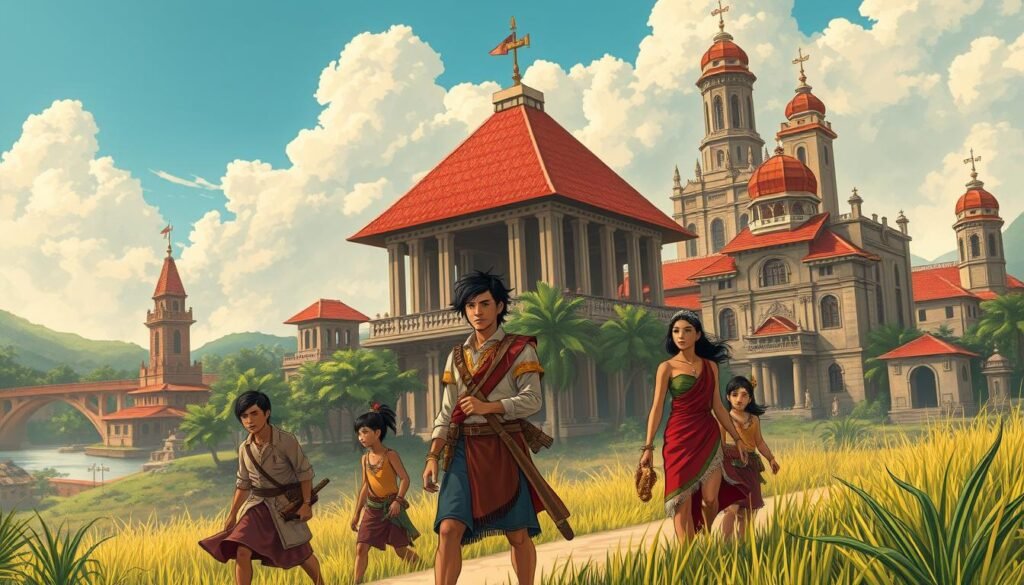
Colonialism’s effects are seen in many parts of Filipino life. This includes language, customs, arts, and education. Understanding these influences helps us grasp the complexities of Filipino identity and heritage.
By recognizing and dealing with colonialism’s legacy, Filipinos can find a more empowered sense of self. This sense celebrates their unique culture and history.
Regional Identities Across the Philippines
The Philippines is a country with a rich cultural diversity. It has over 7,000 islands, divided into three main regions: Luzon, Visayas, and Mindanao. Each region has its own traditions and cultural practices. These contribute to the country’s overall identity.
A sense of belonging to a region can shape one’s personal identity. It also influences their view of the country as a whole.
Here are some key characteristics of each region:
- Luzon: known for being the political and economic heart of the Philippines, with Manila as its capital
- Visayas: recognized for its vibrant culture and strong sense of community
- Mindanao: often felt a sense of isolation from the rest of the country, but takes pride in its agricultural prowess
Understanding and appreciating these regional identities is key. It helps foster national unity and belonging among Filipinos. It also acknowledges the personal connections individuals have with their local communities.
The Role of Family in Shaping Identity
Family is very important in shaping who we are, specially in Filipino culture. The tight bonds in Filipino families deeply affect how we see ourselves. As one source says, “The Filipino culture values family ties a lot.”
In Filipino society, family goes beyond just the immediate family. Grandparents, aunts, and uncles also shape our identity. They pass down traditions and values, teaching us to respect elders and value family time.
Family Structures in Filipino Society
Family structures in Filipino society are rich in heritage and tradition. Many Filipino families work hard to keep their cultural heritage alive. They celebrate traditions like the fiesta, which is a big part of Filipino culture.
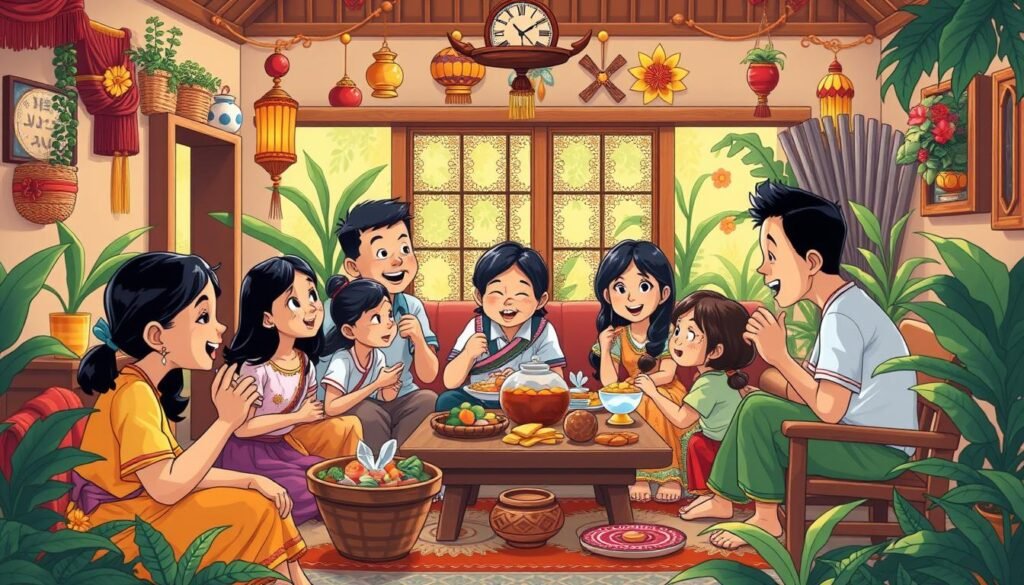
The Influence of Extended Families
Extended families greatly influence our identity. They teach us about loyalty and duty to family. They also offer emotional support and guidance, helping shape who we are.
| Family Structure | Influence on Identity |
|---|---|
| Nuclear Family | Provides basic needs and emotional support |
| Extended Family | Provides emotional support, guidance, and a sense of heritage |
In conclusion, family is key in shaping our identity in Filipino culture. The strong bonds in Filipino families deeply influence our sense of self. Understanding the role of family in Filipino heritage helps us appreciate the complexity of Filipino identity.
The Influence of Religion on Identity
Religion is a big part of the Filipino experience. It brings different beliefs and practices together, making the country diverse. Feeling like you belong to a certain religion is key to who you are. Studies show that religion helps shape our identity, but how much it does can vary.
Young people tend to feel a stronger connection to their religion than older adults.  Scholars see religion in many ways, like as our biggest concern or as a feeling of deep dependence. Durkheim says it’s about beliefs and practices around sacred things.
Scholars see religion in many ways, like as our biggest concern or as a feeling of deep dependence. Durkheim says it’s about beliefs and practices around sacred things.
Some interesting facts about religion and identity are:
- 70% of young people follow their religion every day.
- 40% of people change their religious views during their teens and early twenties.
- 30% of people feel more connected to their community than to just following their religion.
These numbers show how complex and personal religion is. As people explore their faith, they often find themselves and feel closer to their community.
Contemporary Issues Affecting Filipino Identity
The Filipino identity is complex and shaped by a rich culture and heritage. Issues like nationalism, globalization, migration, and social media greatly influence how Filipinos see themselves. They also shape their role in the world.
Some key issues affecting Filipino identity include:
- Nationalism and the struggle to maintain a unique cultural identity in a globalized world
- The effect of migration on identity, as Filipinos move abroad and adapt to new cultures
- The impact of social media on self-perception, as Filipinos present themselves online and interact with others globally
These issues are closely linked to culture and heritage. Filipinos navigate their identity and sense of belonging in a fast-changing world. By tackling these issues, Filipinos can strengthen their identity. They can honor their rich culture and heritage.
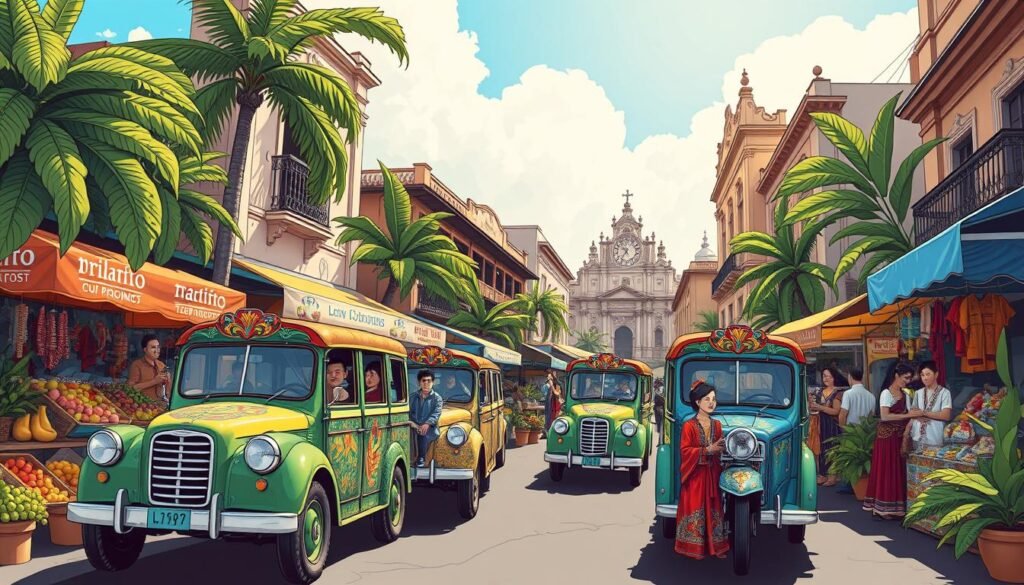
The Filipino identity is dynamic and evolving. It is shaped by history, culture, and current events. By embracing this complexity, Filipinos can create a brighter, more inclusive future. They can do this for themselves and their community.
| Issue | Impact on Filipino Identity |
|---|---|
| Nationalism | Influences sense of national pride and cultural identity |
| Globalization | Exposes Filipinos to diverse cultures and ideas, shaping their sense of self |
| Migration | Affects sense of belonging and identity, as Filipinos adapt to new environments |
| Social Media | Shapes self-perception and presentation, influencing how Filipinos see themselves and interact with others |
The Role of Education in Identity Formation
Education shapes our personal and national identity in today’s world. It helps us feel a sense of belonging, purpose, and citizenship. It also teaches us to value cultural diversity.
But, we should ask, “Where does the heart of the Filipino lie?” This question shows how important it is to understand what Filipinos want and need. These desires change over time and with global changes.
Curriculum and National Identity
The curriculum in schools should help students feel connected to their nation. It should include lessons on cultural awareness and sensitivity. This way, students can learn to appreciate their personal identities.
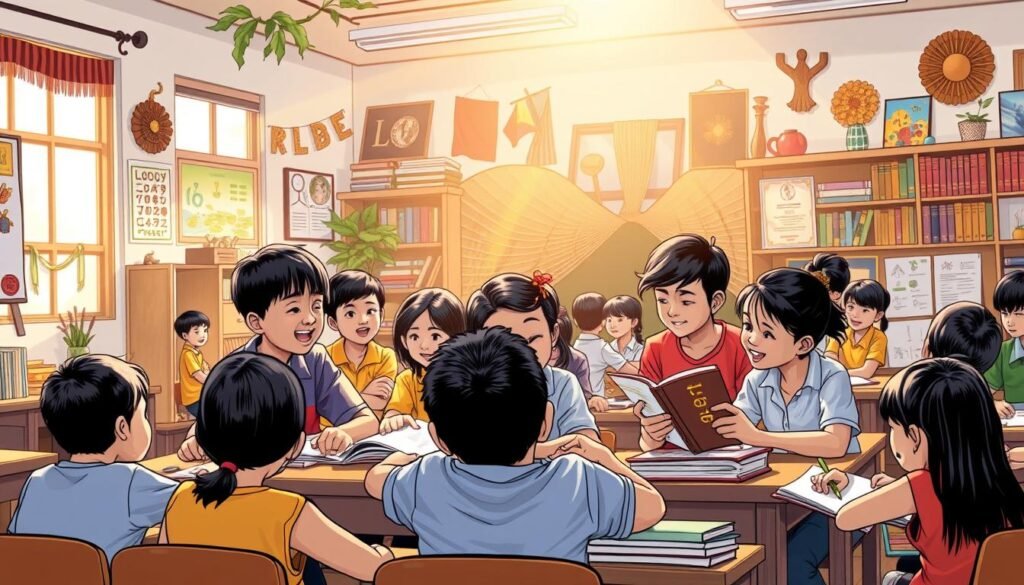
The Importance of Cultural Awareness
Cultural awareness is key in forming our personal and national identity. Schools can teach students to value diversity. This helps them feel a sense of belonging.
As the Filipino identity grows, education will be vital. Schools can give students a strong base in cultural awareness and personal identity. This helps create a more informed and active citizenry.
The Arts as a Reflection of Identity
Art is key in shaping our cultural identity and heritage. It offers a special way to express ourselves and explore our inner worlds. Delacruz (1995) says art is vital in multiculturalism, giving us unique views into different cultures. It helps us appreciate our cultural roots and connect with others deeply.
Al-Zadjali (2017) shows how traditional arts and crafts build our cultural identity. Bhawuk and Brislin (1992) stress the importance of understanding and respecting cultural differences. This is seen in modern Filipino artists who share their life stories and challenge norms, as part of the identity art movement.
The connection between art and identity is complex. Many things shape how we express ourselves through art. Dr. Fernando Zialcita says, “The Filipino brings opposites together,” showing the country’s rich diversity. This is seen in both traditional and modern art forms that highlight Filipino culture and heritage. For example, William Cameron Forbes’ projects in the Philippines, discussed in this article, have greatly influenced the country’s culture and identity.
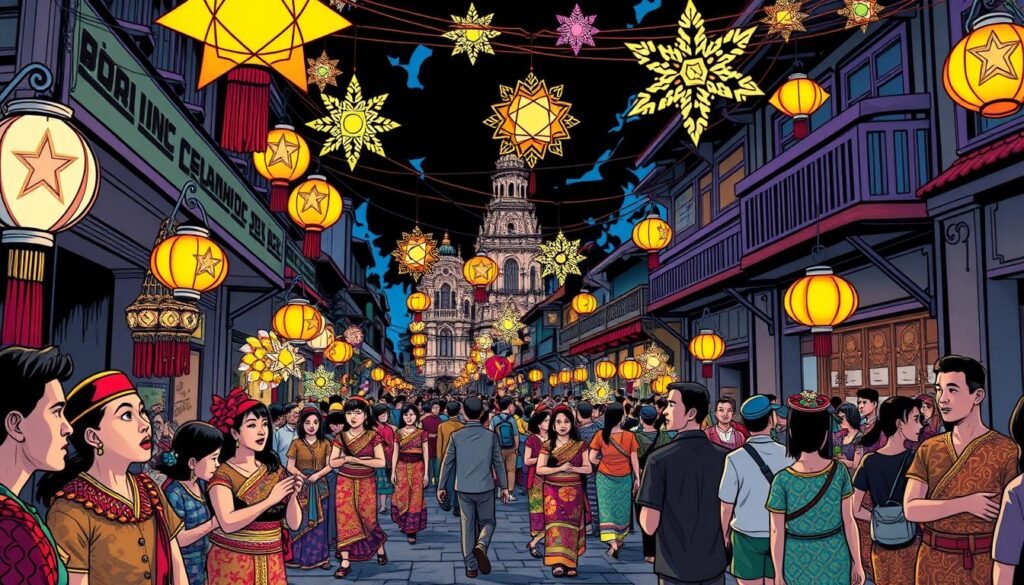
In summary, art is a powerful way to explore and express our identity. Its impact on culture and heritage is significant. Through art, we can understand our cultural roots better and connect with others.
The Intersection of Identity and Gender
Intersectionality helps us understand identity and gender better. It shows how people face different kinds of discrimination at once. This includes racism, sexism, and more. It shows how gender is linked with other identities, leading to more oppression.
A study looked at how sexual and gender identities affect teens. It found that LGBQ and TGD youth face more mental health issues and bullying. This study shows the need to look at how race, money status, and more affect these issues.
In the Philippines, understanding belonging is key. It’s important to include mixed-race Filipinos in our identity. This helps fight racism and discrimination within Filipino society. It shows we need a more open approach to identity and belonging.
We must listen to people from different backgrounds to make society fairer. By talking openly and avoiding simple answers, we can create a better world. The story of Teresa Magbanua shows how important it is to see identity and gender together in our history and culture.
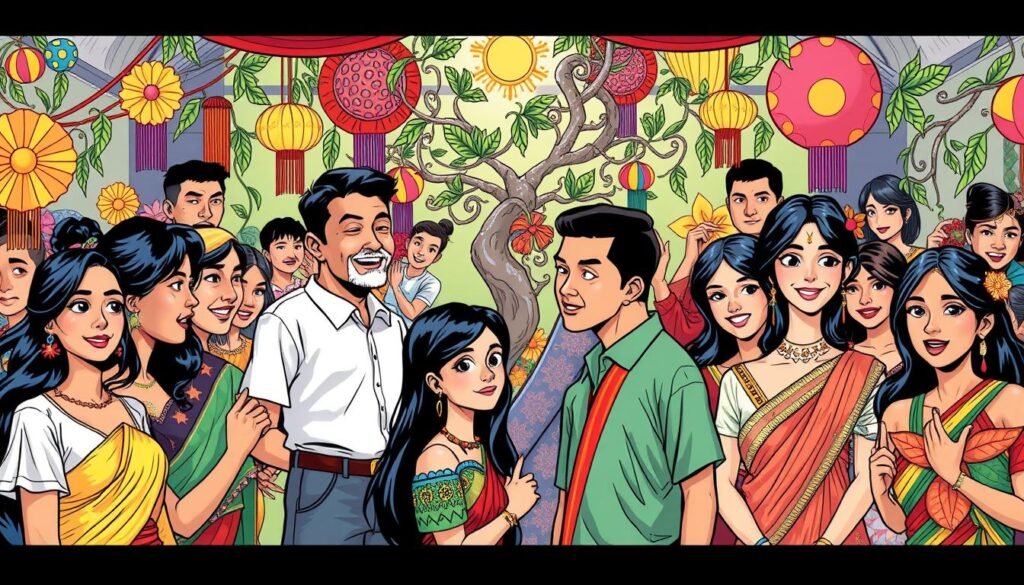
Understanding intersectional identities is key in fighting for social justice. By seeing the complex ways identity and discrimination intersect, we can build a fairer society. A society where everyone feels they belong and can be themselves without fear.
Identity and the Filipino Youth
The Filipino youth are key in shaping the country’s identity. They face today’s trends and issues. Their identity shows a desire to grow and improve, reflecting the nation’s hopes for tomorrow.
Young Filipinos connect deeply with their culture and heritage. They aim to keep their roots alive while welcoming new ideas.
Some key aspects of Filipino youth culture include:
- Strong family values and orientation
- Resilience and adaptability in the face of challenges
- A desire for education and financial security
- A sense of social responsibility and engagement in community issues
Research shows Filipino teens value family a lot. They believe in trusting God, obeying parents, and sticking together. They also want to learn a lot to be financially stable.
The family is seen as a source of happiness and well-being. Good relationships and talking openly with parents make them feel better.
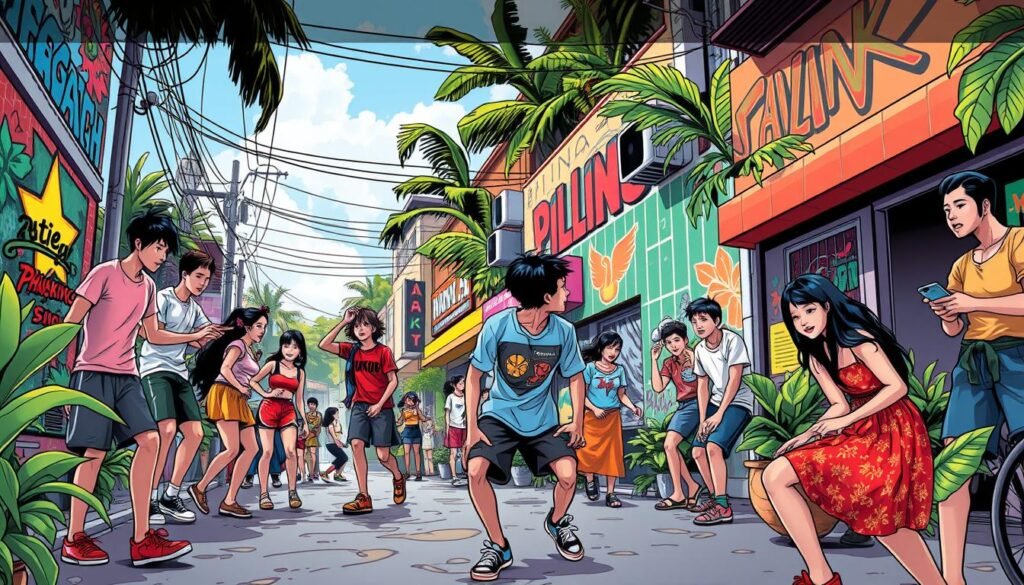
Technology and social media have changed the youth. They use these tools to share themselves, meet others, and talk about important issues. But, there are worries about how tech affects their mental health and the spread of false information.
| Aspect of Filipino Youth Culture | Percentage of Adolescents |
|---|---|
| Intact family structure | 84% |
| Alternative family setups | 16% |
| Value family-oriented virtues | High |
| Aspire to attain high education | High |
The Contribution of Indigenous Peoples to Filipino Identity
The Philippines is home to over 17 million indigenous peoples. They belong to 110 ethnolinguistic groups, each with their own culture and traditions. These communities greatly shape the Filipino experience and add a lot to the country’s identity. Feeling a sense of belonging is key for them, as it helps them keep their cultural heritage alive.
Indigenous peoples in the Philippines face many challenges. These include high illiteracy and unemployment rates. These issues make it hard for them to get social services, jobs, and a say in politics. But, programs like GOJUST are working to help. It has given legal aid to about 2,300 people, helping them know their rights and get involved in the country’s growth.
Education is seen as a way to a better future for indigenous kids. Joy, an 18-year-old studying mining engineering, is a great example. Recognizing the rights and contributions of indigenous peoples is essential for the Philippines’ progress in the 21st century.
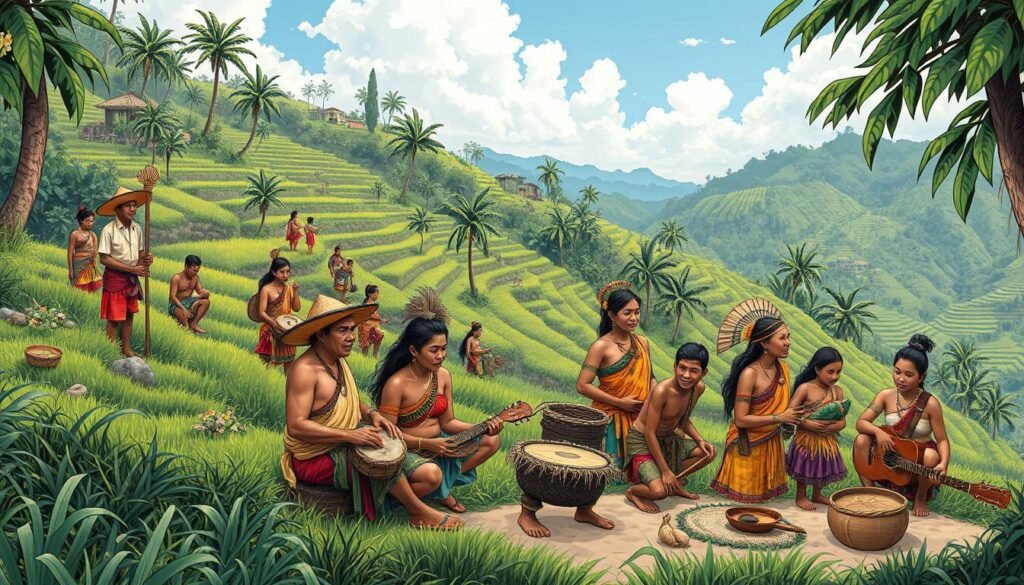
| Indigenous Group | Population | Location |
|---|---|---|
| Manobo | 50,000 | Mindanao |
| T’boli | 30,000 | South Cotabato |
| Blaan | 20,000 | Sarangani |
The Indigenous Peoples’ Rights Act of 1997 (IPRA) in the Philippines protects the rights of indigenous peoples. Senate Bill №1185 aims to safeguard indigenous peoples and local communities in conservation. These efforts aim to balance mainstream law with indigenous customary law, ensuring their rights are respected and protected.
The Future of Filipino Identity
The Filipino identity is changing, and it’s key to keep cultural heritage alive while welcoming new ideas. As the Philippines grows, it’s important to dream of the nation it will become. This vision should show the country’s hopes and dreams.
It’s about finding a balance between culture and modern life. This way, the Philippines’ rich history won’t get lost.
A study shows that colonialism’s impact on the Filipino identity is huge. The Philippines was ruled by Spain for over 300 years, then by America for 48, and Japan for more than three. Understanding this history is key to moving forward and keeping heritage alive.
Keeping culture alive is vital for unity and pride. Creating a database of the Philippines’ diverse cultures is a good start. But, we need more cultural experts and funding to make it happen.
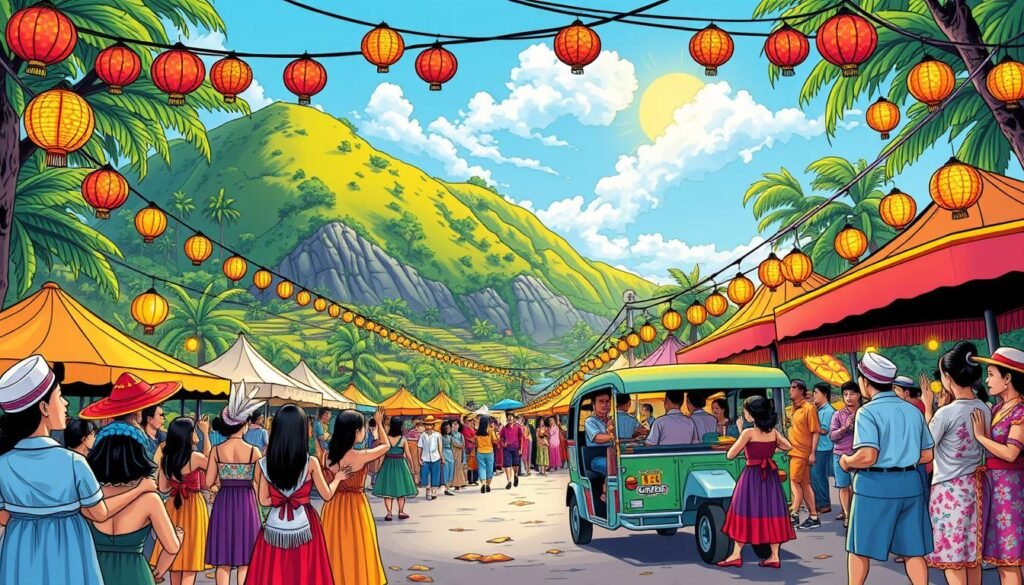
- Promote cultural awareness and education
- Support the preservation of heritage structures and historical sites
- Encourage the use of Filipino languages and the practice of customs and traditions
By doing these things, the Philippines can build a future where its culture and heritage are cherished. This will make the Filipino identity strong and proud.
The Importance of National Symbols
National symbols are key in defining a nation and its people. They create a sense of belonging and unity. Symbols like flags, national anthems, and emblems show a country’s values, history, and culture. They are often used to share a nation’s heritage with the world.
Feeling connected to national symbols can make people proud and patriotic. This is seen when flags are shown during sports and holidays. In the United States, for instance, there are holidays like Flag Day and Independence Day to celebrate.
Here are some examples of national symbols and their importance:
- National flags, which represent a country’s history, values, and culture
- National anthems, which evoke feelings of patriotism and unity
- Emblems, which symbolize a nation’s identity and values
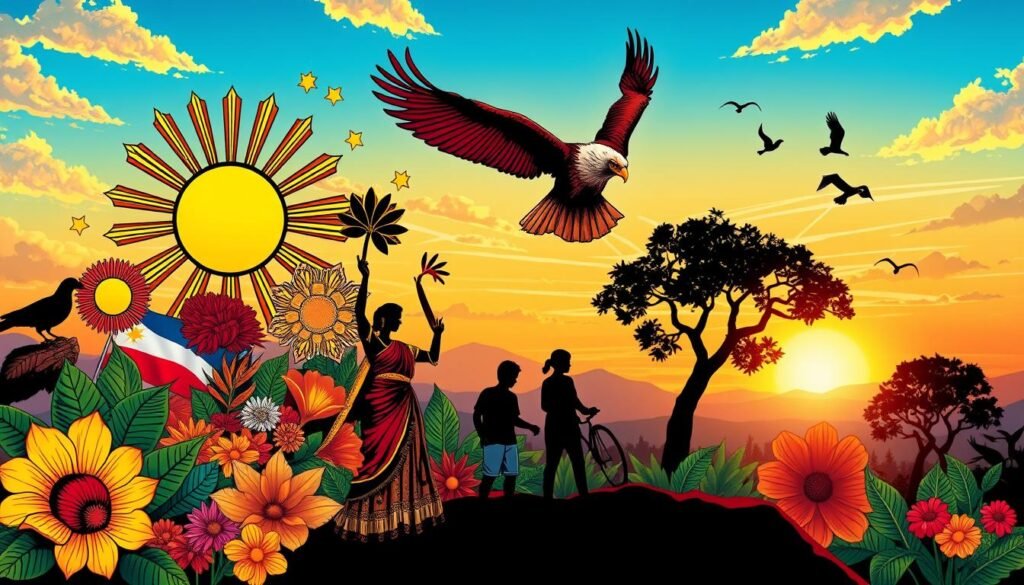
National symbols are vital for creating national identities. They remind us of a nation’s history, values, and culture. They also give citizens a sense of belonging and unity.
| National Symbol | Country | Significance |
|---|---|---|
| National Flag | United States | Represents the country’s history, values, and culture |
| National Anthem | India | Evoke feelings of patriotism and unity |
| Emblem | France | Symbolizes the nation’s identity and values |
Identity in Diaspora: Filipinos Abroad
Millions of Filipinos live and work outside their homeland. This is due to economic needs, political issues, and social reasons. Living abroad mixes Asian and Western cultures, shaping their identity.
Being abroad makes Filipinos proud of their culture and heritage. It changes how they work and interact. For example, their adaptability and hard work are seen in the BPO sector. Knowing English well is also a big plus in their jobs.
Some key traits of the Filipino diaspora include:
- A big number of Filipinos work in healthcare, like in the UK’s National Health Service.
- At least 10% of the Philippines’ people work or live abroad for better jobs.
- There are many types of migration, from permanent to temporary and irregular.
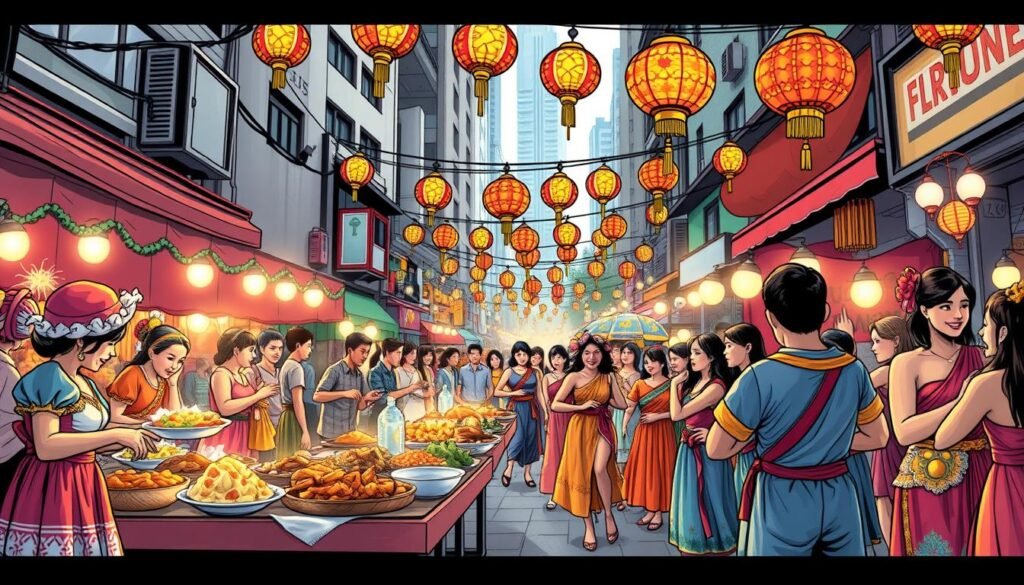
The Filipino diaspora is complex and diverse. It’s shaped by many factors and affects the culture and heritage of those abroad. By understanding this, we can build a stronger sense of identity and community among Filipinos in the diaspora.
Conclusion: The Ongoing Story of Filipino Identity
The Filipino identity is always changing. It’s made up of history, culture, and personal belonging. This identity is complex, with many layers, shaped by the country’s diverse regions, past influences, and global changes.
At its core, there’s a strong wish to understand and shape oneself. This is true for every Filipino.
The future of Filipino identity will mix old traditions with new ways. The country will face both challenges and chances in a fast-changing world. It’s up to all Filipinos to take part in this journey, embracing the unique aspects of their identity.
By keeping cultural heritage alive, talking openly, and learning about their varied histories, Filipinos can keep their identity strong and flexible. This path of self-discovery is ongoing. It will uncover new parts of the Filipino spirit, inspiring future generations.
FAQ
What are the key historical influences that have shaped the Filipino identity?
The Filipino identity has been shaped by many historical events. The Spanish and American colonizations have left a lasting impact on the country’s culture and identity.
How does the cultural diversity of the Philippines contribute to the Filipino identity?
The Philippines’ cultural diversity is key to its identity. Each region, like the Visayas, Mindanao, and Luzon, brings its own unique traditions. This diversity enriches the country’s culture.
What is the role of language in the development of the Filipino identity?
Language is vital to the Filipino identity. It shows the country’s cultural richness. Different dialects and languages across the Philippines add to the Filipino experience.
How has the colonial legacy in the Philippines impacted the Filipino identity?
Colonial history has deeply influenced the Filipino identity. The Spanish and American colonizations have left a mark on the country’s culture and heritage. Understanding this legacy helps grasp the Filipino identity’s complexities.
What is the role of family in shaping the Filipino identity?
Family is essential in forming the Filipino identity. The bonds within families, extended families, and traditions passed down through generations are key. They help shape who Filipinos are.
How does religion influence the Filipino identity?
Religion, mainly Catholicism, has a big impact on the Filipino identity. Indigenous beliefs and other religious movements also play a role. Religion intersects with social issues, adding to the identity’s complexity.
What are some of the contemporary issues affecting the Filipino identity?
Today, issues like nationalism, globalization, migration, and social media affect the Filipino identity. These challenges make the identity complex, blending traditional values with modern influences.
How does education play a role in shaping the Filipino identity?
Education is critical in forming the Filipino identity. The curriculum, cultural awareness, and higher education shape how individuals see themselves and their place in the world.
In what ways do the arts reflect the Filipino identity?
The arts, including traditional and modern forms, reflect the Filipino identity. They offer a platform for self-expression and identity exploration. This highlights the country’s cultural diversity and complexity.
How does the intersection of identity and gender impact the Filipino experience?
Gender and social issues influence the Filipino identity. Different groups face unique challenges and discrimination. The complexities of gender roles, feminism, and LGBTQ+ rights add to the identity’s multifaceted nature.
What is the role of the Filipino youth in shaping the country’s identity?
The Filipino youth are key in shaping the country’s identity. They navigate contemporary trends and issues. Their culture, engagement in social issues, and use of technology evolve the Filipino identity.
How do indigenous peoples contribute to the Filipino identity?
Indigenous peoples are vital to the Filipino identity. Their pre-colonial heritage, contemporary movements, and rights recognition are integral to the country’s cultural diversity and identity.
What is the significance of national symbols in the Filipino identity?
National symbols, like the flag and anthem, are important in shaping the Filipino identity. They represent the country’s values and cultural heritage.
How does the Filipino identity manifest in the diaspora?
Living abroad makes the Filipino identity complex. It creates a sense of duality between traditional values and modern influences. The Filipino-American experience, overseas workers, and community building abroad shape the evolving identity in diaspora.
Source Links
- Reimagining Filipino Identity – https://medium.com/kids-for-kids/reimagining-filipino-identity-f9b1182c0233
- Filipinx American Identity: A Personal (Ongoing) Journey of Positionality – https://reappropriate.co/2023/09/filipinx-american-identity-a-personal-ongoing-journey-of-positionality/
- Filipino – Core Concepts – https://culturalatlas.sbs.com.au/filipino-culture/filipino-culture-core-concepts
- ‘Kapwa,’ ‘hiya,’ and the search for Filipino identity – https://opinion.inquirer.net/176895/kapwa-hiya-and-the-search-for-filipino-identity
- Facets of Filipino identity – https://opinion.inquirer.net/139607/facets-of-filipino-identity
- Echoes of Tirad Pass: Impact of the US’s Colonial Legacy in the Philippines on Current Philippine-American Relations | YIP Institute – https://yipinstitute.org/capstone/echoes-of-tirad-pass-usa-colonial-legacy-in-the-philippines
- Tangkilikin ang sariling atin: Presence of colonial mentality among Filipinos today – https://animorepository.dlsu.edu.ph/cgi/viewcontent.cgi?article=1569&context=conf_shsrescon
- PDF – https://www.ijoes.in/papers/v6i1/10.PHILIPPINE (129-135).pdf
- Regional and Factional Mentality of Filipinos – https://www.nipino.com/regional-and-factional-mentality-of-filipinos
- Ethnicity, Regionalism, and Language of the Philippines | TOTA – https://www.tota.world/article/1121/
- The Role of Family in Shaping an Individual’s Identity and Values – https://aithor.com/essay-examples/the-role-of-family-in-shaping-an-individuals-identity-and-values
- The Roots of Our Stories: Family and the Forging of Identity – https://www.psychologytoday.com/intl/blog/progress-notes/202010/the-roots-our-stories-family-and-the-forging-identity
- Microsoft Word – 2 – https://aijcrnet.com/journals/Vol_3_No_6_June_2013/2.pdf
- Religion and Identity – https://www.facinghistory.org/resource-library/religion-identity
- What Problem with Filipino Identity? – https://www.getrealphilippines.com/2016/02/filipino-identity/
- Filipino, Too: Compositions on Culture and Identity – https://aquila.usm.edu/cgi/viewcontent.cgi?article=1282&context=dissertations
- The role of education in shaping personal and national identity in a globalized world – https://aithor.com/essay-examples/the-role-of-education-in-shaping-personal-and-national-identity-in-a-globalized-world
- The Role of School in Adolescents’ Identity Development. A Literature Review – Educational Psychology Review – https://link.springer.com/article/10.1007/s10648-018-9457-3
- PDF – https://minerva-access.unimelb.edu.au/bitstream/handle/11343/191885/04_NAbbasi.pdf
- The Significance of Art in Revealing a Culture’s Identity and Multiculturalism – https://www.scirp.org/journal/paperinformation?paperid=130687
- Self-Reflection: A Promise that keeps shaping my Artist identity/Journey – https://www.linkedin.com/pulse/self-reflection-promise-keeps-shaping-my-artist-kiggundu-rodney-1drxf
- The Intersection of Art & Identity: How Creativity Shapes Our Sense of Self – Pinot’s Palette – https://www.pinotspalette.com/naperville/blog/creative-life/pinotspalettenaperville-the-intersection-of-art-and-identity-how-creativity-shapes-our-sense-of-self
- Gender and Intersectionality – https://thecompassforsbc.org/trending-topics/gender-and-intersectionality
- Understanding Intersectional Identities – https://www.psychologytoday.com/intl/blog/understanding-the-erotic-code/201906/understanding-intersectional-identities
- Intersectionality | LBGTIQ Intersect – https://www.lgbtiqintersect.org.au/learning-modules/intersectionality/
- Adolescent devt in the Context of Filipino Family – https://www.dlsu.edu.ph/wp-content/uploads/pdf/sdrc/working-papers/WP-series-No-7-Adolescent-devt-in-the-Context-of-Filipino-Family.pdf
- The Filipino youth and the question of identity – https://cbcpnews.net/cbcpnews/the-filipino-youth-and-the-question-of-identity/
- PDF – https://www.pssc.org.ph/wp-content/pssc-archives/Philippine Journal of Psychology/2009/Num 2/04_Adolescent Identity in the Context of the Filipino Family.pdf
- Towards inclusion for indigenous peoples in the Philippines – https://www.unops.org/news-and-stories/stories/towards-inclusion-for-indigenous-peoples-in-the-philippines
- The Role of Indigenous Peoples in Philippine Society – https://medium.com/@2020047211/the-role-of-indigenous-peoples-in-philippine-society-2971f2353158
- PDF – https://www.undp.org/sites/g/files/zskgke326/files/migration/ph/fastFacts6—Indigenous-Peoples-in-the-Philippines-rev-1.5.pdf
- A nation with no identity – https://opinion.inquirer.net/173293/a-nation-with-no-identity
- PDF – https://pdp.neda.gov.ph/wp-content/uploads/2017/01/Chapter-7-Prepublication.pdf
- Importance of national symbols, national identity – https://www.dailypioneer.com/2023/state-editions/importance-of-national-symbols–national-identity.html
- The Importance of National Symbols to National Identity – https://www.academia.edu/32202156/The_Importance_of_National_Symbols_to_National_Identity
- Balikbayan: The Filipino Diaspora and Its Impact on the Cultural Identity and Work Ethic of Employees Today – https://www.yoonet.io/insights/balikbayan-the-filipino-diaspora-and-its-impact-on-the-cultural-identity-and-work-ethic-of-employees-today
- 6aguila-the filipino, diaspora.pmd – https://journals.upd.edu.ph/index.php/socialsciencediliman/article/download/4798/4330/
- The instinctive community-building practices of the Filipino diaspora – https://shado-mag.com/opinion/the-instinctive-community-building-practices-of-the-filipino-diaspora/
- In the Quest of Identity – Filipino’s Recurring Dream – https://www.linkedin.com/pulse/quest-identity-filipinos-recurring-dream-carlo-alison-sobingsobing
- ‘Culture as History’: Nick Joaquin’s provocative essay on Filipino identity – https://reversedelay.net/2015/12/22/culture-as-history-nick-joaquin-provocative-essay-on-filipino-identity/

